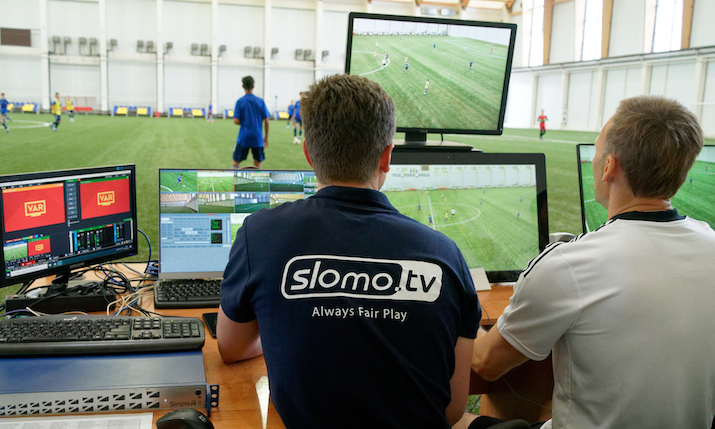Changing the TV world: Slomo.tv on affordable broadband data connections with low latency and the JPEG-XS standard
 By Igor Vitiorets, Slomo.tv CTO.
By Igor Vitiorets, Slomo.tv CTO.
The pandemic and economic recession continue to reshape TV production and the television industry. During the pandemic, the entire TV industry was forced to turn towards remote production. If before 2020 industry stakeholders were aware of all the pros and cons of remote production, then in 2021 they all decided to ignore the cons, adapted and benefited from its advantages.
In the vast majority of cases, the remote production was based on H.264/265 codecs and streaming protocols like SRT, RTMP, RTSP, etc. Such solutions worked fine in those cases where video delivery time was not crucial. Some of the solutions are still in use today, even though pandemic-related restrictions have already been removed in many countries. This can serve as proof that these solutions were really needed and matched the price/performance expectations of users.
When it comes to sports video production, one of the most important parts of the modern TV world, solutions based on Long GOP MPEG-based codecs and SRT, RTMP, RTSP protocols are not suitable for use in live broadcasts because of the high latency. Using SRT/H.264 is a good example. For comfortable operation with relatively unnoticeable latency, both with control interfaces and with live two-way communication, the latency should not exceed 300 milliseconds. In fact, working with interfaces, a comfortable latency, determined by human physiology, is no more than 150 milliseconds.
In this case, a simple enough solution seems to use an intra frame codec, preferably with line-by-line coding. Such a codec is JPEG-XS, which is characterised by a very low latency: up to 32 lines. However, on the other hand, being a lightweight codec, it has a low compression rate and, therefore, a larger stream.
In order to maximise the benefits of JPEG-XS, a broadband and ultra-low latency data connection is required. Actually, the solution can be the use of network data transmission technology DWDM/λ. The Lambda (λ) is a point-to-point DWDM service, which can replace the dark fibre service and eliminate the need for repeaters between the service end-points.
The Lambda does not use TCP/IP technology or routers. This ensures that the data delivery latency is actually determined only by the speed of light propagation in the fibre optic. When using the JPEG-XS video coding standard, it is almost always possible not to exceed a comfortable latency of 150 milliseconds. For high-level video production, an important benefit is the reliability of the data transfer when using protected Lambda (λ) technology. In this case, data transfer recovery is guaranteed in no longer than 50 milliseconds.
Wider adoption
All of these technologies already existed before the pandemic, but it promoted the widespread adoption of such technologies by telecommunications companies. Prices for such services have dropped, making it available to a wider range of users.
So, how can this be leveraged? And how are these technologies already used in sport video production? Here are a few cases.
The VAR centres that receive video from stadiums using this technology fully benefit from it: very low signal latency allows video referees and replay operators to monitor the game without delays noticeable to all the parties involved. This enables instant review of game moments with minimal impact on the natural course of the game. Having the VAR servers in one centralised location saves significant hardware costs. The VAR centre also reduces the time and cost of travel for personnel. Not least, it physically separates the place of play from the place where the VAR decisions are made, thus avoiding all sorts of influences on the video referees.
Hybrid VAR
Another example related to VAR is the so-called hybrid VAR technology. In this installation option, the VAR server itself is located at the stadium and the video referees and match officials are located in the VAR centre. In this case, only the interfaces are transmitted to the VAR centre, and thanks to the comfortable latency provided by Lambda/JPEG-XS, the video referee team work from a VAR centre thousands of kilometres away from the stadium and server without noticing it. Savings on travel and personnel are also evident.
The same Lambda/JPEG-XS-based remote solution, in which only interfaces are transmitted, is used for the work of replay operators, whose workplaces are located in the office of the television company. Operators do not travel to the sites, but comfortably work with the server located at a great distance from them. The workflow does not differ from what they are used to.
Of course, we should mention the case when camera signals from an OB van are transmitted with Lambda/JPEG-XS technology to the main control room of the TV company, where all the work on formatting the programme is carried out. In fact, it saves on equipment that does not need to be installed in each OB van, reduces travel expenses and increases staff availability: no time is spent on trips.
However, it is worth remembering that video engineers, technicians and camera operators still need to be onsite to set up, connect and work with the equipment. A fully remote high-quality TV production is not yet possible.
